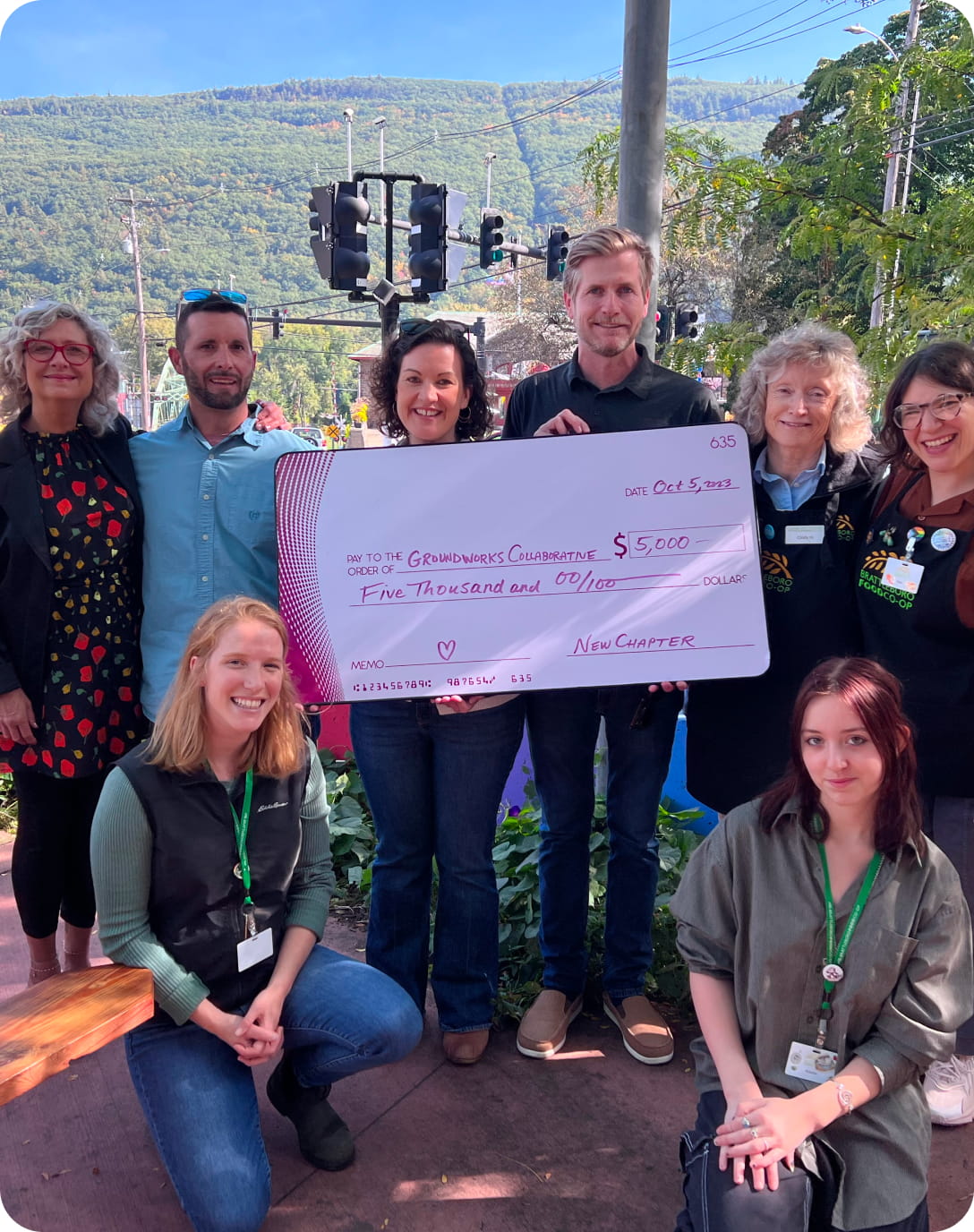Rhapsody Natural Foods
Elysha and Sjon Welters reside on a beautiful homestead way up in northern Vermont, along with their business, Rhapsody Natural Foods. They’re living out their vision of creating foods that nourish themselves, their family, their community, and the Earth. The care and attention they give to their work comes through in the rich flavors and tender textures of all their products. Try any of them for yourself, and you’ll understand: Rhapsody foods are on another level.
The homestead is in Cabot, VT, about an hour from the Canadian border. It is there on their seventeen-acre property that they’ve built their home, raised their family, and created a life and business built on values that they hold dear. They make a small selection of high-quality fermented products: absurdly delicious tempeh, miso, natto, and a small number of other products. Their three children have houses and kids of their own on the land, and the neighboring property is home to a loose intentional community, into which the Welters family is also integrated. All told, there are about forty people, from all walks of life, backgrounds, and political persuasions, who live on the two abutting properties. The one thing they share in common is a desire to live in harmony with their neighbors in a loving community.
The first thing they produced for commercial sale was tempeh. When describing Rhapsody’s tempeh the number one thing you must know is that not all tempeh is created equal! To be sure, all tempeh is a great addition to any meal. It’s a complete protein, and it’s fermented, which makes the soybeans easier to digest. And the dense, chewy texture is satisfying as a stand-in for meat. All the tempeh we carry is high quality and tasty in its own right, but Rhapsody’s tempeh is truly different. The texture is more tender and velvety, and the flavor is nutty and sweeter. You need to try it for yourself to understand.
How is it that Rhapsody tempeh is such a cut above the rest? It’s a combination of a few different factors. First, the ingredients: they only use organic soybeans, mostly grown right over the border in Quebec, and fresh well water from their property. Second, the cook: as a former macrobiotic chef, Sjon knows how to cook beans. They need to be done just right for tempeh–slightly firmer than usual (because the fermentation process softens them further), but soft enough to get that pillowy yet meaty result. To retain as many nutrients as possible, they steam the beans rather than boil them. Then there’s the fermentation: the cooked soybeans are mixed with two different Rhyzopus mold cultures and incubated. Rhapsody makes small batches that are fermented for longer than the typical time. Though the fermentation is technically complete after about 24 hours, theirs continue for 30-35 hours until the color has darkened and some black spots appear. The process cannot be completely standardized because, as Sjon and Elysha explained, the tempeh mold is a living thing, sensitive to changes in temperature, humidity, and other aspects of the environment. Despite the environmental controls in their production facilities, the fermentation time shifts slightly with each batch, especially around the change of seasons. For Rhapsody, making tempeh is a hands-on process that requires attention and care.
But there’s also an X factor to Rhapsody’s foods that’s more intangible. Sjon and Elysha really believe that to make good food, there has to be good feeling. They make sure that the work environment they create is a happy, peaceful place, and that their seven employees feel supported and engaged. They all share in the various duties and tasks without being held to a rigid schedule–the aim is to integrate work into a balanced, meaningful life. Their staff also care about the food they’re creating, not just their paycheck–they believe in Rhapsody’s mission to make the world a kinder, more harmonious place through their gentle foods. All of this contributes to an atmosphere of communality and joy, which, for Elysha and Sjon, is a crucial ingredient in all their recipes.
After fermentation, the tempeh is pasteurized. It may come as a surprise to learn that this is in line with tradition. Sjon explained that, in tempeh’s birthplace of Indonesia, the soybeans were hulled by stomping on them with bare feet, much like grapes for wine. Instead of eating it raw like other fermented foods, it’s traditionally fried or steamed. This would kill any unwanted lifeforms that may have arisen in that process. Of course, Rhapsody’s tempeh is made with stainless steel equipment in a spotlessly clean environment, but the practice of heating the tempeh to a high temperature before consuming it remains. Rhapsody also makes two outstanding marinated varieties: Teriyaki and BBQ. Because the tempeh is pre-cooked, it can be eaten directly out of the package for a scrumptious addition to a salad or sandwich, but these really shine when heated. Even just a quick turn in a microwave is enough to make it delectably moist, soft, and flavorful. The marinade makes it not only a snackable savory-sweet food–it’s also even more tender and toothsome than the plain variety. And the ingredients are quite clean: brown rice syrup is the sweetener, not cane sugar. Use it as a lightning-quick main protein for a fast, truly delicious, healthy meal.
The origins of tempeh are more mysterious than other traditional soy-based foods. We know that it comes from what we today call Indonesia, but when it was first created is uncertain. It’s accepted that it almost definitely pre-dates the 19th century, but it may be a thousand years old or more. And because Indonesia is a former Dutch colony, it also has a relatively long history in the Netherlands, where Elysha and Sjon are originally from. Tempeh was being produced commercially in Europe by the 1950s, but it wasn’t until the hippie health food craze of the ‘70s that it came to the fore. In fact, it was this movement towards eating and living closer to the Earth that brought Elysha and Sjon together. Elysha became macrobiotic at the age of 18, after her brother inspired her and her parents to follow in his footsteps. He was an early adopter of natural foods, and owned and operated a business called Manna, which Elysha described as the Bread and Circus of Holland back in those days (it has since closed). She met Sjon when he was working in the kitchen of one of the Manna facilities.
The Welters moved to the USA in 1983, and 14 years later settled at their current spot in Cabot. Although the call to move to the States was purely intuitive, they can now see how the move from Europe allowed them to live the lives they were destined for. Back in the Netherlands, it’s necessary to complete certain degrees and get certifications to do things like open a restaurant. They love and appreciate Holland, but according to Sjon, if you learn through hands-on experience or want to do things differently, it’s a challenging place to make a start. Here in the States, things are relatively free and open. They didn’t need much besides their own vision and resources to start the restaurant they ran shortly after coming to Vermont. Their establishment was a beloved vegan eatery in Montpelier.
Eventually, the Vermont company that made the tempeh they used at their restaurant closed and, dissatisfied with the alternatives, they decided to make their own. This is true of everything Rhapsody produces–Sjon and Elysha make the foods they enjoy and want to eat. Their line of products grew to include other fermented foods, and over time, their production business developed to the point where it needed its own facility and focus. Sjon built the first small manufacturing facility on their homestead, and Rhapsody Natural Foods was born.
One of the foods they longed for but were unable to find was natto. In 2014 they finally began selling this unique superfood. What is it? Like tempeh, it is made from soybeans. But instead of mold, it’s fermented with a bacteria called Bacillus subtilis natto, which is naturally present in rice straw. It originates in Japan, where it’s a staple breakfast food. If you have heard of natto, you have probably also heard that it’s an acquired taste: people who love it absolutely love it, but people who don’t… they really don’t. It has a strong smell that some folks can’t handle, much like some pungent cheeses. But if you don’t instantly take to it, the health benefits of it might encourage you to learn to enjoy its peculiar flavor. It’s been studied a great deal and has been found to provide all sorts of health benefits. It has a very high level of vitamin K2, which breaks down calcium so that it’s absorbed by our bones instead of accumulating on artery walls. And it contains nattokinase, which helps ensure healthy blood clotting. Other studies have also indicated positive qualities concerning other viruses and diseases. You can find links to numerous scientific studies that go into a lot of detail on the subject on the Rhapsody Natural Foods website. If you’re curious to try natto, head to the freezer section at our Co-op. We carry Rhapsody’s Small Bean Natto in small green cups near the frozen fruit. It’s traditionally eaten with soy sauce and mustard (the vinegar in mustard neutralizes the strong natto flavor): put some of each on the defrosted natto, and stir rapidly till it becomes stringy. If you have not yet acquired the taste, Sjon recommended putting a small amount in a bowl of soup. Don’t cook the natto, just add a spoonful to the bottom of your bowl before ladling some soup over it. Stir and enjoy this superfood with gusto!
Whenever scientific studies about the health benefits of natto make it into mainstream media, Rhapsody invariably sees a spike in sales. And this is typical of their marketing strategy. Sjon likened advertising to putting fertilizer on your business: it can speed up growth, but what they’re looking for is a more grounded success. They make high-quality products that they love to eat, and that quality speaks for itself. Through word of mouth, they’ve been able to sustain a holistically healthy business for over twenty years.
The other product we carry at the Co-op from Rhapsody is miso. They make two types: Mellow Red and Sweet White. The red miso is fermented with koji spores for at least six months. The white is less salty and has aged for at least six weeks. Both have an unusual sweet smoothness–again, the magic of Rhapsody is at work. It just tastes better than other miso! Simply mix a spoonful with some hot water, and you have an instant, deeply nourishing treat. Add a bit of sesame oil and a touch of tamari, and it’s even more wonderful. Boil the water (not the miso) with some kombu seaweed and a bit of tofu before adding it to the miso paste, to create a delightful addition to any meal. Miso is also a versatile ingredient in sauces and marinades of all varieties. It packs a rich umami punch along with its probiotic profile. Sjon recommended the Sweet White as a perfect base for dressings, as it’s a bit less salty, and the Mellow Red as an excellent addition to sautéed vegetables (though heat will remove its probiotic qualities, the flavor is fantastic and is a gentler alternative to salt). He also recommended another simple but unusual recipe: crumble a four-pound block of tofu and mix it with 16-24 oz of white miso and let it sit at room temperature for a few days. This transforms into a delicious vegan cheese, and because the tofu is slightly fermented, it’s more nutritious and easier to digest. The big takeaway from Sjon and Elysha is that miso is worth experimenting with! Let your imagination be your guide–it’s almost impossible to fail with such tasty, high-quality ingredients.
After learning about Elysha, Sjon, and Rhapsody Natural Foods, it becomes clear why their products taste so good: it’s because they care. We are so lucky to have them on our shelves. Next time you’re in our Co-op, take the opportunity to enjoy these special, small-batch, lovingly created hand-made foods.
By Ruth Garbus
About Producer of The Month

Shop Online

On Sale Now!

